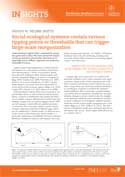Insight #2 Regime shifts

Social-ecological systems contain various tipping points or thresholds that can trigger large-scale reorganisation.
Regime shifts are large, persistent, often abrupt changes in the structure and function of social-ecological systems. A regime shift occurs when there is a switch in the dominant feedbacks, and is often associated with rapid non-linear change as the system reorganizes into a different structure and function.
Such a switch can occur when a large shock (e.g. hurricane, political turbulence) or combination of shocks overwhelm the dominant system feedbacks. More commonly, a gradual change (e.g. habitat loss, accumulation of pollutants, emergent markets, changes in values) slowly erodes the strength of the dominant feedbacks until a threshold is reached at which a different set of feedbacks suddenly becomes dominant and the system rapidly reorganizes into a new regime (Biggs et al. in press, Folke et al. 2011).
The slow erosion of feedbacks usually goes unnoticed until the actual regime shift occurs — hence regime shifts often occur as a surprise (see illustration below).
Understanding of regime shifts is important for ecosystem governance as they often have substantial impacts on human economies and societies, tend to occur unexpectedly, and are difficult, expensive and sometimes impossible to reverse.
Key findings
1. Regime shifts are typical features of SES, not rare, isolated phenomena.
2. Important regime shifts arise from the interaction of social and ecological factors.
3. Regime shifts in SES have large impacts on ecosystem services and human well-being.
4. Regime shifts may take the form of socialecological transformations.
5. Regime shifts are difficult to detect.
6. Managing regime shifts requires different approaches than managing more gradual social-ecological change.









